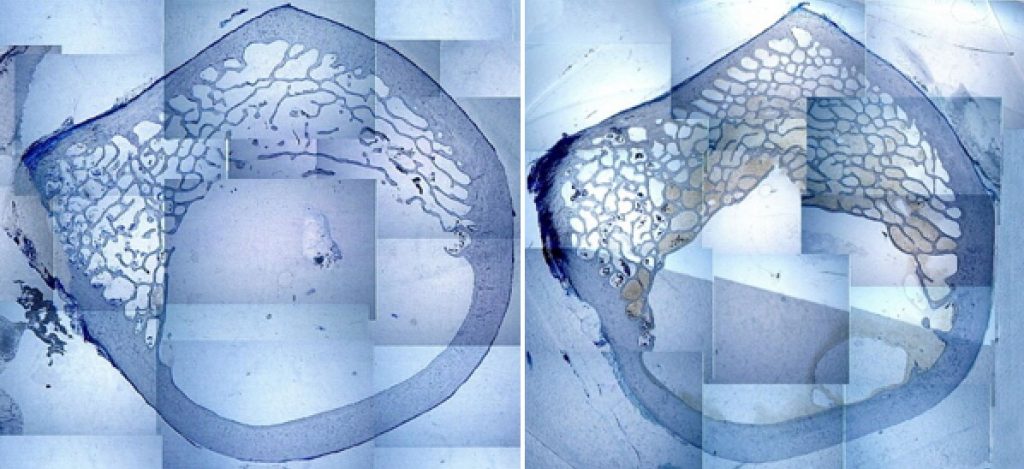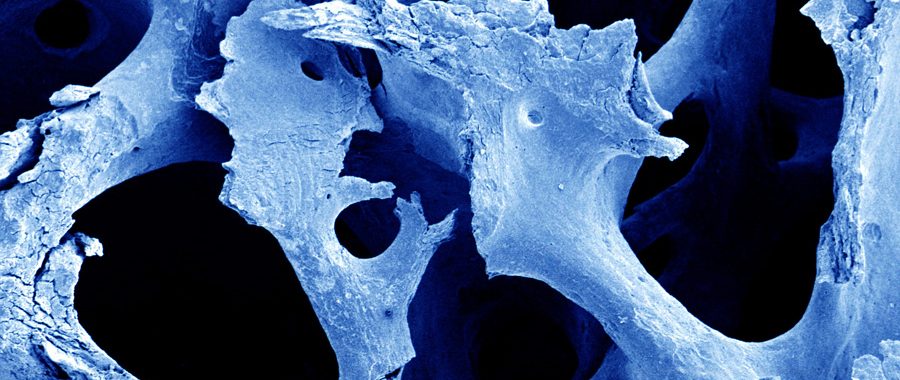Osteoporosis is a disease of the bones. The underlying mechanism is an imbalance between bone formation and bone resorption, which can lead to a high risk of fracture. Low intensity vibration (LiV) is a safe and effective non-drug intervention to correct this imbalance and treat osteoporosis.
Treatment with Marodyne LiV is safe and effective for osteoporosis built on a foundation of basic and applied science
The mechanism of Marodyne LiV on maintaining or growing bone mineral density is achieved in part by activating osteoblast activity (bone builders) and inhibiting osteoclast activity (bone resorbing). Research has also shown that Low intensity vibration (LiV) promotes mesenchymal stem cell differentiation towards osteoblasto genesis (bone formation) and away from adipogenesis (fat formation).
Bone stability
The objective of osteoporosis treatment is to build – or at least maintain – bone stability. Having measured the bone mineral density, a treatment programme will aim to improve the T-scores with the goal being to get you out of the osteoporotic zone. Measuring at intervals, normally at the first yearly anniversary since treatment started and then annually from then on, shows the effectiveness of the treatment. The two most important parts of osteoporosis treatment are a diet sufficient in calcium and vitamin D and regular physical exercise. Medication can be prescribed but without a diet rich in vitamins and minerals and appropriate physical exercise, its effect is limited.
Wolff’s Law
Wolff’s Law was developed by a Berlin physician, Julius Wolff, during the 19th Century following a series of observations and measurements of bones. Wolff’s Law is today one of the fundamental rules of orthopaedic work: it applies in particular to osteoporosis treatment. The main concept of Wolff’s Law is that bone actively adapts to loads and relative forces. In simple terms, if bones are subjected to loads and stress, the body reacts by building up more bone to withstand the force being applied. Both external and internal bone tissue reacts in this way. As bone increases in strength and builds itself up when subjected to loads the reverse is also true: bone decreases in strength and breaks down if it’s not used or subjected to loads.
The effect of applying or removing load to bone
When applying increased load to a bone it will adapt and remodel itself over time to become stronger, to handle the increased force. The reverse is also true that if the loading on a bone decreases the bone will remodel itself to become weaker and less dense as there is not enough stimulus to be strong.

The left image shows bone with less dense – the right image shows remodeled bone after treatments with LiV.
Benefits of Marodyne LiV
Marodyne LiV is safe and usable by anyone – elderly, untrained, deconditioned, injured, disabled or as a preventive measure by the fit & healthy.
Indications for use
– Safe and effective treatment of osteoporosis
– Maintaining and increasing bone mineral density (BMD)
– Building muscle strength & muscle mass in the legs
– Stimulate blood circulation & lymphatic flow
– Improve balance, postural and co-ordination
– No side-effects
– Meets all safety requirements of ISO2631: mechanical vibration
Bone responds to both large low frequency and small high frequency forces, these forces enable bone to grow and stay healthy. The device provides a very precise low level vibration (0.4g) which is transmitted at a high frequency (30Hz) to the person on the device. Precise low intensity vibration mimic the small high frequency forces exerted by muscles onto the bone. This stimulates osteoblast (bone builder) activity while inhibiting osteoclast (bone resorbing) activity.
Research has shown that low intensity vibration delivers mechanical signals to the skeleton. A one year placebo-controlled research study of postmenopausal women demonstrated that low-level vibration effectively inhibit bone loss in the spine and femur. (1)
Another study showed that short bouts of LiV increased bone and muscle mass in the weight-bearing skeleton of young adult females with low BMD. (2)
A third study in a large group of women over 60 years or age showed a significant reduction in falls and fractures in the group that used LiV compared to a normal exercise group. (3)
Based on these scientific findings and other research the LiV device has been developed as a non-drug treatment to fight osteoporosis.
References
1 Rubin C, Recker R, Cullen D, Ryaby J, McCabe J, McLeod K; Prevention of postmenopausal bone loss by a low-magnitude, high-frequency mechanical stimuli: a clinical trial assessing compliance, efficacy, and safety. Journal of Bone and Mineral Research (2004)
2 Gilsanz V, Wren T, Sanchez M, Dorey F, Judex S, Rubin C; Low-Level, High-Frequency Mechanical Signals Enhance Musculoskeletal Development of Young Women With Low BMD. Journal of Bone and Mineral Research (2006)
3 Leung KS, Li CY, Tse YK, Choy TK, Leung PC, Hung VW, Chan SY, Leung AH, Cheung WH; Effects of 18-month low magnitude high-frequency vibration on fall rate and fracture risks in 710 community elderly—a cluster-randomized controlled trial. Osteoporosis International (2014)

